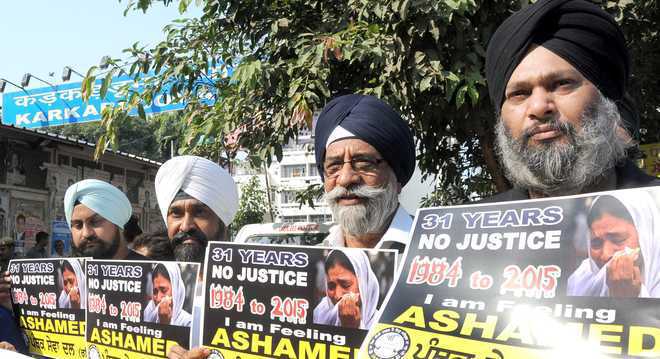
Rahul Bedi
Senior journalist
The recent Delhi High Court judgment upholding the trial court’s conviction of 88 persons for their role in the Sikh pogrom in East Delhi’s Trilokpuri in 1984 has come almost two generations after the horrendous massacres in India’s Capital stunned the world.
Thirty-four years after the slaughter of some 350 Sikhs in two alleyways in this trans-Jumna resettlement colony, these convictions are unlikely to engender even a modicum of closure for the survivors and their families.
In what can only be called a cruel joke, the guilty have been sentenced to five-year imprisonment for their involvement in butchering Sikhs in Trilokpuri’s Block 32 for 48 hours from November 1, 1984, the day after Indira Gandhi’s assassination by her two Sikh bodyguards.
The slaughterers took time off for meals, before returning to resume their savagery against the colony of Dalit migrant Sikhs, many of who eked out a meagre existence weaving charpoys. Their only sin, like thousands of other victims, was that they were Sikhs.
The killers had no fear of police or the authorities in satiating their blood lust, calculatedly planned by senior Congress politicians armed with voter lists. It would also be humanly unfeasible for Trilokpuri’s survivors to erase the picture of their lanes littered with bodies, body parts and mounds of hair brutally hacked off in an odious bid to obliterate their Sikh identity.
It was impossible for anyone walking down this alley, once the killings were done, to place their feet flat on the ground, for fear of stepping on either a body or a scythed limb. This macabre scene was set horrifically against a patina of sticky blood, partially coagulated in the November chill over which flies and insects buzzed incessantly.
Amidst the carnage a young polio-afflicted mother sat emotionlessly in the doorway of her tenement cradling her baby girl; the bodies of almost all her male family members lay gruesomely piled high behind her.
As a group of newspaper journalists — including myself — who had stumbled upon the slaughter, gingerly navigated their way towards her, she wordlessly surrendered her child to them in an act of capitulation and hopelessness. We lifted them up and handed them over to a handful of local policemen, who by now had arrived, never to see either of them again.
Alongside, a three-year-old girl, stepping over the bodies of her father and three brothers and countless others lying in the street clung helplessly to one of us, pleading mutely for help. She wanted to be taken home, not realising that she was already there but it was knee-deep in corpses.
But the most spine-chilling part of this grisly setting was the total silence that hung over the killing zone, despite it being surrounded by hundreds of people who, no doubt included the perpetrators.
There was not a whisper from the mob, as the defused light from a couple of hastily lit Hurricane lanterns added to the ghoulish scenario as we stumbled our way over human remains. Hundreds of pairs of bloodthirsty eyes malevolently followed our every move in an encounter that even 34 years later remains terrifying.
The official toll in Delhi, in what is decorously referred to as the 1984 riots, was around 2,730. A more realistic casualty figure tabulated by rights activists, however, is around twice that number.
At the time, all Sikhs in Delhi were unable to comprehend the cataclysmic events that brought this bloody apocalypse upon them as the state turned avenger and systematically supervised the massacre of their easily identifiable community.
It seemed they had failed to realise that the earth had moved in response to a big tree falling. Consequently, as the blood letting eased, thousands of traumatised Sikhs staggered out of hiding, flocking to hastily erected refugee camps in gurdwaras and school compounds, as their homes lay charred, pillaged or both. Nobody had an answer for them, as they set about the grim task of cremating their dead and putting their shattered lives in order.
The carnage ended only with Indira Gandhi’s funeral on November 3. Thereafter, Army units, deployed earlier across Delhi in a haphazard and diffused manner, were finally issued shoot-to-kill orders by the federal government to control marauding mobs and restore some semblance of order.
It was possibly the first time in recent history that the state, headed by the Congress had participated in seeking revenge and later to cynically exploit Mrs Gandhi’s murder to ensure India’s biggest-ever electoral victory for her son and heir Rajiv.
Over decades, at least nine inquiry commissions, interminable and indeterminate court proceedings, and more recently, judicially monitored Special Investigation Teams followed, with the feeble aim of punishing the guilty for the 1984 pogrom and bringing closure to victims’ families.
No senior police officer, state official, politician or anyone in authority associated with orchestrating the massacres has been indicted. Many reportedly involved in the killings had died, and the endless investigative and judicial processes against former Congress MPs Sajjan Kumar and Jagdish Tytler for their alleged role are unlikely, after 34 years, to reach a retributive conclusion.
In August, Congress president Rahul Gandhi told an audience in London that his party was in no way involved in the 1984 pogrom. Give it another few years and perhaps the Congress will even deny that the carnage happened.



























